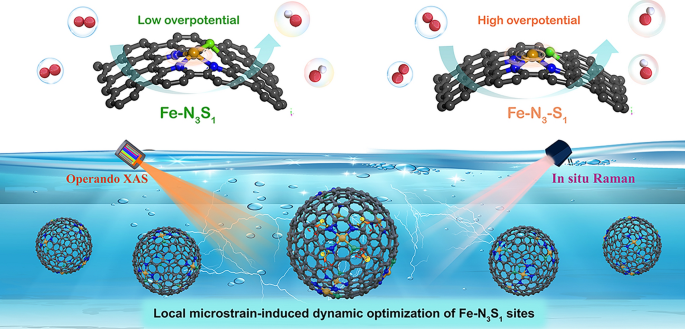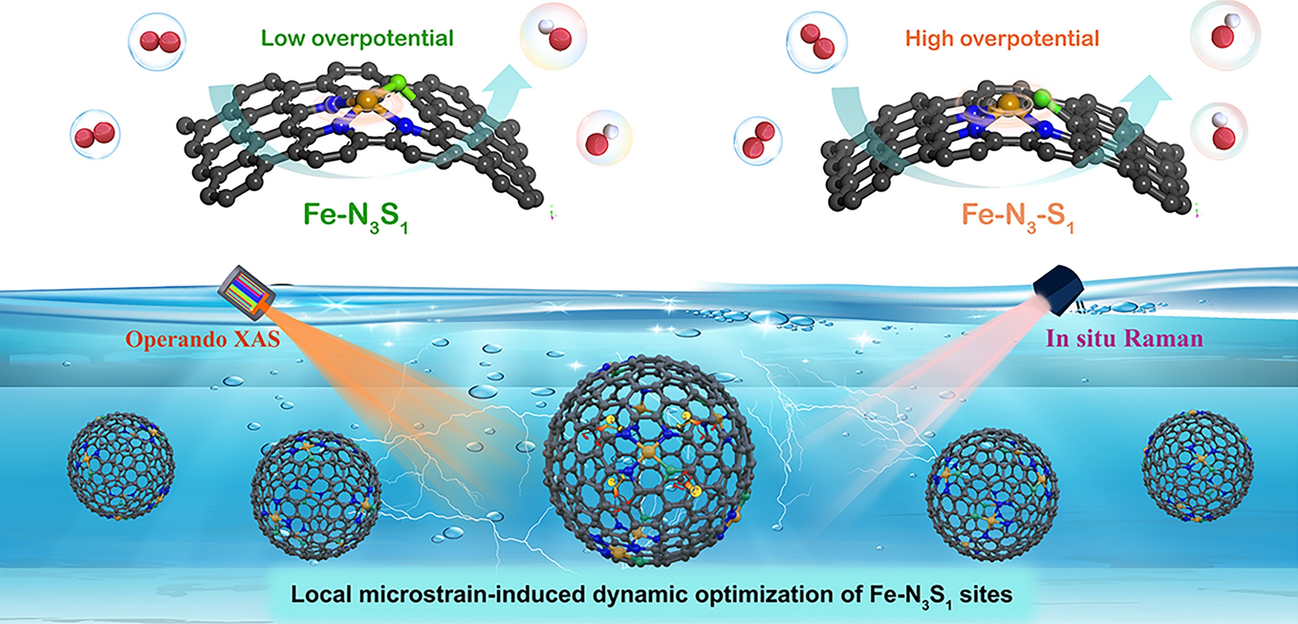Deciphering Local Microstrain-Induced Optimization of Asymmetric Fe Single Atomic Sites for Efficient Oxygen Reduction

Oxygen electrocatalysis stands at the heart of next-generation metal–air batteries and fuel cells, yet the age-old trade-off between activity and durability persists. Now, a joint team from the State Key Laboratory of Heavy Oil Processing at China University of Petroleum (East China) and Peking University, led by Professor Yuan Pan, reveals how local microstrain can be exploited as a precise tuning knob for single-atom catalysts (SACs). Their study, published in Nano-Micro Letters, demonstrates that curvature-controlled strain on hollow carbon nanospheres unlocks record-setting ORR performance and long-term stability.
Why Microstrain Matters
- Asymmetric Coordination Breakthrough: Replacing one N with S in the classic Fe–N4 plane forms Fe–N3S1 moieties, disrupting symmetry and alleviating over-adsorption of *OH intermediates.
- Curvature-Induced Strain: A 20 nm hollow nanosphere imposes 3 % compressive strain on Fe–N bonds and 1.5 % tensile strain on Fe–S bonds, down-shifting the Fe d-band center and accelerating *OH desorption kinetics.
- Dynamic Self-Optimization: Operando XAS and in-situ Raman reveal that the strained Fe–S bond selectively breaks under high over-potentials, converting Fe–N3S1 into Fe–N3 and further mitigating *OH poisoning while preserving Fe–N integrity.
Engineering the Strained Architecture
- One-Pot Silica-Templated Route: Coal-tar pitch, melamine and hemin chloride co-assemble around sacrificial SiO2 spheres (20 nm vs. 180 nm), followed by NH3 pyrolysis at 900 °C and HF etching to yield FeNS-HNS-20 with tunable curvature.
- Quantitative Active-Site Density: AC-HAADF-STEM confirms 31 nm inter-atomic spacing and isolated dispersion; nitrite-stripping quantifies 6.2 e⁻ s-1 site-1 turnover frequency (TOF), 1.7× that of flat analogues.
- Bifunctional Durability: After 20000 ORR cycles, half-wave potential loss is <4 mV, outperforming commercial 20 % Pt/C (40 mV loss after 5000 cycles).
Characterizing the Strain Effect
- Operando Spectroscopy: Fe K-edge XANES tracks Fe–S bond elongation and subsequent rupture at 0 V vs. RHE, evidenced by coordination number drop from 0.9 → 0.2.
- DFT Free-Energy Landscape: Strained FeNS-HNS-20 lowers the *OH desorption barrier to 0.73 eV, compared with 0.87 eV for flat FeNS-NS, aligning with measured Tafel slopes and RRDE electron-transfer numbers (n ≈ 3.97).
- Device-Level Validation: Rechargeable Zn–air batteries deliver 214 mW cm-2 peak power density and 2200 cycles (1100 h) without voltage decay—surpassing Pt/C (184 mW cm-2, <300 cycles).
Future Outlook
- Curvature Library Expansion: Extending the strategy to Co-, Ni-, or Mn-SACs could universalize strain-tunable electrocatalysis.
- Scalable Fiber Electrodes: Hollow nanospheres can be spray-coated or electro-spun into gas-diffusion layers for kW-scale fuel-cell stacks.
- Solid-State Integration: The same geometric strain principle is being adapted for solid-state Zn–air pouch cells, targeting >400 Wh kg-1gravimetric energy.
By translating nanoscopic curvature into controllable bond strain, the Chai team transforms single-atom catalysts from static motifs into dynamically self-optimizing centers, pushing metal–air technology ever closer to commercial reality.
Follow the Topic
-
Nano-Micro Letters

Nano-Micro Letters is a peer-reviewed, international, interdisciplinary and open-access journal that focus on science, experiments, engineering, technologies and applications of nano- or microscale structure and system in physics, chemistry, biology, material science, and pharmacy.






Please sign in or register for FREE
If you are a registered user on Research Communities by Springer Nature, please sign in